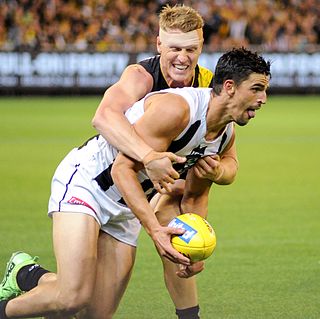
Most forms of football have a move known as a tackle. The primary purposes of tackling are to dispossess an opponent of the ball, to stop the player from gaining ground towards goal or to stop them from carrying out what they intend.

Rugby union football, commonly known simply as rugby union or more often just rugby, is a close-contact team sport that originated at Rugby School in the first half of the 19th century. Rugby is simply based on running with the ball in hand. In its most common form, a game is played between two teams of 15 players each, using an oval-shaped ball on a rectangular field called a pitch. The field has H-shaped goalposts at both ends.
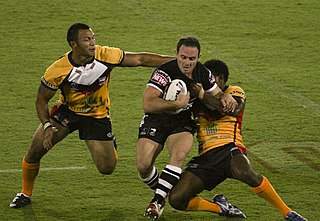
Rugby league football, commonly known as just rugby league and sometimes rugby, football, footy or league, is a full-contact sport played by two teams of thirteen players on a rectangular field measuring 68 m (74 yd) wide and 112–122 m (122–133 yd) long with H shaped posts at both ends. It is one of the two codes of rugby football, the other being rugby union. It originated in 1895 in Huddersfield, Yorkshire, England, as the result of a split from the Rugby Football Union (RFU) over the issue of payments to players. The rules of the game governed by the new Northern Rugby Football Union progressively changed from those of the RFU with the specific aim of producing a faster and more entertaining game to appeal to spectators, on whose income the new organisation and its members depended.
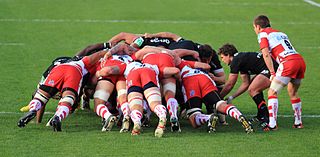
A scrummage, commonly known simply as a scrum, is a method of restarting play in rugby football that involves players packing closely together with their heads down and attempting to gain possession of the ball. Depending on whether it is in rugby union or rugby league, the scrum is used either after an accidental infringement or when the ball has gone out of play. Scrums occur more often, and are now of greater importance, in union than in league. Starting play from the line of scrimmage in gridiron football is derived from the scrum.

In the game of rugby union, there are 15 players on each team, comprising eight forwards and seven backs. In addition, there may be up to eight replacement players "on the bench", numbered 16–23. Players are not restricted to a single position, although they generally specialise in just one or two that suit their skills and body types. Players that play multiple positions are called "utility players".
In rugby football, the penalty is the main disciplinary sanction available to the referee to penalise players who commit deliberate infringements. The team who did not commit the infringement are given possession of the ball and may either kick it towards touch, attempt a place kick at goal, or tap the ball with their foot and run it. It is also sometimes used as shorthand for penalty goal.
A rugby league team consists of 13 players on the field, with 4 substitutes on the bench. Each of the 13 players is assigned a position, normally with a standardised number, which reflects their role in attack and defence, although players can take up any position at any time.
In sports, a utility player is one who can play several positions competently. Sports in which the term is often used include association football, basketball, American football, baseball, rugby union, rugby league, softball, ice hockey, and water polo.
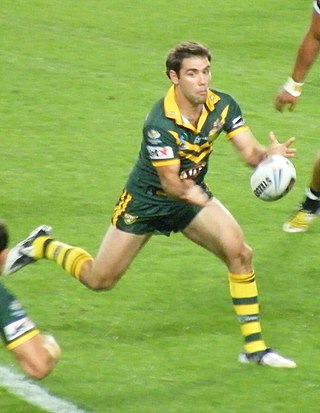
Like most forms of modern football, rugby league football is played outdoors on a rectangular grass field with goals at each end that are attacked and defended by two opposing teams. The rules of rugby league have changed significantly over the decades since rugby football split into the league and union codes. This article details the modern form of the game and how it is generally played today, although rules do vary slightly between specific competitions.

A comparison of American football and rugby union is possible because of the games' shared origins, despite their dissimilarities.

The team sports rugby union and rugby league have shared origins and thus many similarities.

Rugby union is a contact sport that consists of two teams of fifteen players. The objective is to obtain more points than the opposition through scoring tries or kicking goals over eighty minutes of playing time. The play is started with one team drop-kicking the ball from the halfway line towards the opposition. The rugby ball can be moved up the field by either carrying it or kicking it. However, when passing the ball it can only be thrown laterally or backward. The opposition can stop players moving up the field by tackling them. Only players carrying the ball can be tackled and once a tackle is completed the opposition can compete for the ball. Play continues until a try is scored, the ball crosses the side line or dead-ball line, or an infringement occurs. After a team scores points, the non-scoring team restarts the game at the halfway with a drop kick toward the opposition. The team with the most points at the end wins the game.
This is a general glossary of the terminology used in the sport of rugby union. Where words in a sentence are also defined elsewhere in this article, they appear in italics.
Rugby league football has accrued considerable jargon to describe aspects of the game. Many terms originate in the Laws of the Game. Some aspects of the game have more than one term referring to them. Different terms have become popularly used to describe an aspect of the game in different places, with notable differences between the Northern and Southern Hemispheres.

Flanker is a position in the sport of rugby union. Each team of 15 players includes two flankers, who play in the forwards, and are generally classified as either blindside or openside flankers, numbers 6 and 7 respectively. The name comes from their position in a scrum in which they 'flank' each set of forwards. They compete for the ball – most commonly in rucks and mauls. Flankers also assist in pushing in a scrum, but are expected to detach from the scrum as soon as the ball is out to get to the play before the opposition's forwards. Flankers also participate in line-outs, either being lifted to contest or win possession, or to lift other players. Flankers are usually the key participants in the tackling process. The flankers, especially the openside, are often the fastest forwards on the team but still relied upon for tackling.

In rugby union a scrum is a means of restarting play after a minor infringement. It involves up to eight players from each team, known as the pack or forward pack, binding together in three rows and interlocking with the three opposing teams front row. At this point the ball is fed into the gap between the two forward packs and they both compete for the ball to win possession. Teams can be penalised for intentionally causing the scrum to collapse, and for not putting the ball into the scrum correctly. A scrum is most commonly awarded when the ball is knocked forward, or passed forward, or when a ball becomes trapped in a ruck or maul. Because of the physical nature of scrums, injuries can occur, especially in the front row.
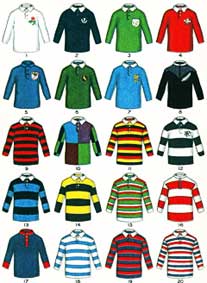
A traditional rugby union kit consists of a jersey and shorts, long rugby socks and boots with studs. The other main piece of equipment is the rugby ball.

Alfred James Webb was an English-born international rugby union footballer who played club rugby for Abertillery, and county rugby for Monmouthshire. He won 20 caps for Wales and was part of the 1910 touring British Isles team to South Africa.
Enrique "Topo"Edgardo Rodríguez is an Argentina-born Australian former rugby union player.
A comparison of Canadian football and rugby union is possible because of the games' shared origins, despite their dissimilarities.













